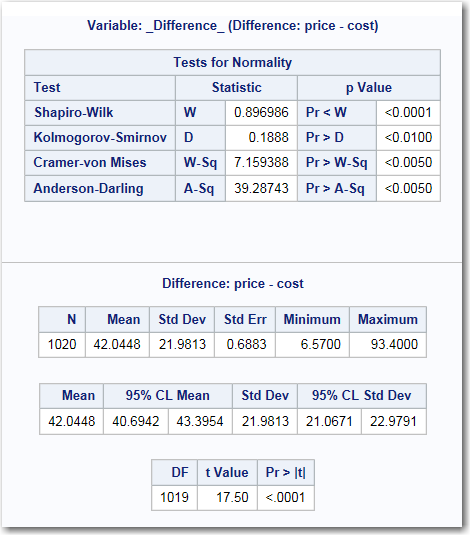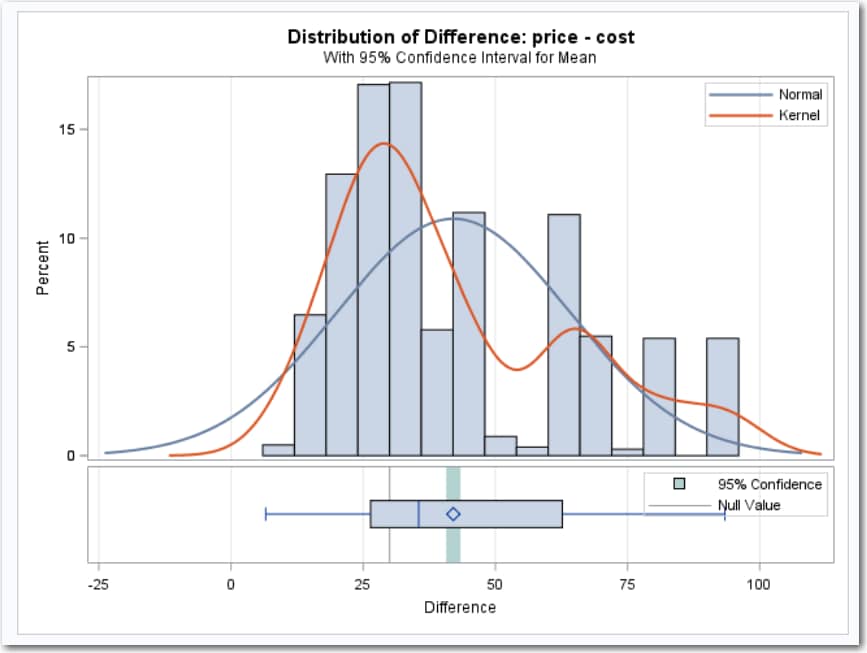Paired Test
About the Paired t Test
A paired t test
compares the mean of the differences in the observations to a given
number, the null hypothesis difference. The paired t test
is used when the two samples are correlated, such as two measures
of blood pressure from the same person.
To compare n paired
differences to a value m, use  , where
, where  is the sample mean of the paired differences and s2d is
the sample variance of the paired differences.
is the sample mean of the paired differences and s2d is
the sample variance of the paired differences.
 , where
, where  is the sample mean of the paired differences and s2d is
the sample variance of the paired differences.
is the sample mean of the paired differences and s2d is
the sample variance of the paired differences.
To run a paired t test,
open the t Tests task. From the t test drop-down
list, select Paired test.
Example: Determining the Distribution of Price – Cost
In this example, you
want to compare the means of differences in price and cost in the
Sashelp.Pricedata data set. The null hypothesis for this test is 30.
To create this example:
-
TipIf the data set is not available from the drop-down list, click
 . In the Choose a Table window,
expand the library that contains the data set that you want to use.
Select the data set for the example and click OK.
The selected data set should now appear in the drop-down list.
. In the Choose a Table window,
expand the library that contains the data set that you want to use.
Select the data set for the example and click OK.
The selected data set should now appear in the drop-down list.
Setting Options
|
Option Name
|
Description
|
|---|---|
|
Tests
|
|
|
Tails
|
specifies the number
of sides (or tails) and direction of the statistical tests and test-based
confidence intervals. You can choose from these options:
|
|
Alternative
hypothesis
|
specifies the value
of the null hypothesis.
|
|
Normality Assumption
|
|
|
Tests for
normality
|
runs tests for normality
that include a series of goodness-of-fit tests based on the empirical
distribution function. The table provides test statistics and p-values
for the Shapiro-Wilk test (provided the sample size is less than or
equal to 2000), the Kolmogorov-Smirnov test, the Anderson-Darling
test, and the Cramér-von Mises test.
|
|
Nonparametric Tests
Note: This option is available
only for a two-tailed test.
|
|
|
Sign test
and Wilcoxon signed rank test
|
generates the results
from these tests:
|
|
Plots
|
|
|
Histogram
and box plot
|
creates a histogram
and box plot together in a single panel, sharing common X axes.
|
|
Normality
plot
|
creates a normal quantile-quantile
(Q-Q) plot.
|
|
Agreement
plot
|
plots the second response
in each pair against the first response. The mean is shown as a large
bold symbol. A diagonal line with slope=0 and y-intercept=1 is overlaid.
The location of the points with respect to the diagonal line reveals
the strength and direction of the difference or ratio. The tighter
the clustering along the same direction as the line, the stronger
the positive correlation of the two measurements for each subject.
Clustering along a direction perpendicular to the line indicates negative
correlation.
|
|
Response
profile plot
|
creates a plot where
a line is drawn for each observation from left to right that connects
the first response to the second response. The mean first response
and mean second response are connected with a bold line. The more
extreme the slope, the stronger the effect. A wide spread of profiles
indicates high between-subject variability. Consistent positive slopes
indicate strong positive correlation. Widely varying slopes indicate
lack of correlation. Consistent negative slopes indicate strong negative
correlation.
|
|
Confidence
interval plot
|
creates a plot of the
confidence interval for the means.
|
Copyright © SAS Institute Inc. All rights reserved.








